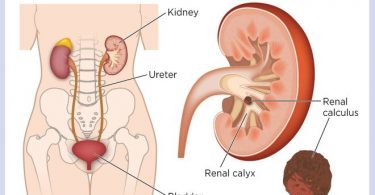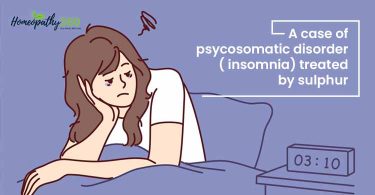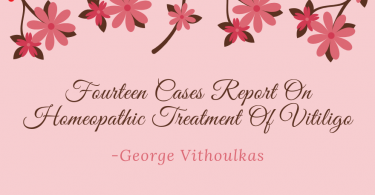Homoeopathy, also spelt homœopathy: the therapeutic system founded by the German Physician S. C. F. Hahnemann. (Born Meissen 1755, died Paris 1843).
The name originates from the Greek words “όμοιος”=”homos” (similar) and “πάθος”=”pathos” (disease, suffering).
The Law of Similars: like cures like
The whole system is based mainly upon the principle that the cure of a disease is accomplished by drugs that are capable of producing, in a healthy individual, similar symptoms (suffering) to those of the disease to be treated.
For instance, it is well known that Belladonna causes mydriasis, ie enlargement of the pupil. In a case of mydriasis, the homeopathic doctor will prescribe Belladonna in a highly diluted potency to bring the pupil to its normal state. Another example is Digitalis, widely used by orthodox medicine to reduce tachycardia, ie excessive rapidity in the action of the heart. In homeopathy, Digitalis in high potency will be indicated in some cases of bradycardia, where the pulse rate is very slow.
This principle was expressed by Hahnemann with the Latin motto
“Similia Similibus Curentur. ” “Let similars be treated with similar. ” Hahnemann maintained that this is a basic law of cure.
The idea was mentioned originally by Hippocrates, but it had also been expressed by Paracelsus and others.
The provings
To ascertain the curative virtues of the drugs Hahnemann suggested that they should be “proved” upon healthy persons – that is to say, they should be taken by individuals of both sexes in gradually increasing doses, but not beyond the subtoxic levels. The manifestations of drug action thus produced were carefully recorded. This record of “drug-symptoms, ” the signs and symptoms produced on relatively healthy organisms, after being verified by repetition on many “provers, ” and combined with the toxicological effects of some of the drugs that were known through the then existing medical literature, constitutes the distinguishing feature of a voluminous homeopathic pharmacopoeia called “Materia Medica”.
The main theories of Hahnemann
Based on the “Law of Similars” and the provings of the drugs upon human organisms, Hahnemann proceeded to develop an entire medical system. He published his theories for the first time in his main book “Organon of the Art of healing” in 1810. In 294 Aphorisms he expounds the principles of his System of Medicine.
He later published his “Materia Medica Pura, ” in which he included all the drugs that he himself and his followers had proved upon themselves and others. He also published his “Chronic Diseases” in which he claimed that all chronic diseases were the result of suppressed skin eruptions, suppressed syphilis and suppressed gonorrhoea.
He considered that these three groups of diseases – when wrongly treated – remained within the organism in an altered form, eventually manifesting themselves as chronic diseases. He called them the miasms of Psora, Syphilis and Sycosis ( by sycosis he meant the gonorrheal miasm).
Hahnemann was strongly criticised for these theories, even by some of his own followers, who thought they abandoned this idea as useless still practised homeopathy.
Some essential points of Homeopathic theories that complement “the Law of Similars” are :
- That there are no diseases as such, but only diseased individuals.
- That the indicated remedy should fit the symptoms of each individual case and not of the disease.
- That the necessary amount (dose) of the remedy needed to bring about a cure is the smallest possible one, indeed an infinitesimal one.
- That the symptoms of a disease, during the process of a cure disappear in the reverse order of their coming.
The individualisation of the case
An important concept that Hahnemann introduced, differentiating homeopathy from mainstream medicine, was individualisation.
As he maintained that there are no diseases as such but only diseased individuals. the treatment of the sick should be aimed at the cure of the individual rather than his disease. According to such a concept ten patients suffering from the same “disease”, for example, epilepsy would possibly receive ten different drugs, unless their symptom manifestations were identical down to the last detail, an infrequent but not impossible occurrence.
The prescription of the drug for each case should be guided by the similarity of the drug pathogenesis, “the provings”, and correspond to the individualised specific and peculiar symptomatology of the patient.
The defence mechanism.
The complex mechanism of the defence system of the organism was collectively called by Hahnemann “the vital force”.
This expression implies that behind the material defence mechanism there exists in the organism an energy-like state, an “intelligent force” that supervises and synchronises the actions and reactions of the organism.
The logic behind such thinking, according to homeopaths, 1 lies in the understanding that symptoms are nothing more than the response of the human organism’s defence mechanism. The fever rises, for instance, in order to counteract an infecting agent, such as bacteria, viruses, fungi, etc., and the organism needs to be supported in its curative effort, rather than repressed.
Homeopaths believe that in giving a drug that is capable of producing, on a healthy individual, symptoms similar to those present in the patient, they are in effect stimulating and at the same time supporting the defence mechanism in its effort to get rid of the disease.
Homeopaths maintain that the real cause of the disease is not the infecting agent, but, rather, a weak defence mechanism which accepts the disease, a weak immune system. By strengthening the immune system instead of killing the microbes they believe that they are doing more to produce a lasting state of health in the individual. To contemporary homeopaths it is evident that vaccination is based on similar logic.
Corroboration of the “Law of Similars” is shown by established medicine’s adoption of the serum therapy when treating such diseases as diphtheria, where a modified form of the infecting agent is introduced into the patient’s system.
Opponents maintain that homeopaths do not look for the real cause of a disease which, they claim, is often an infecting agent. Homeopaths maintain that by strengthening the defence mechanism they actually go deeper into the real cause of the imbalance, which is the weakness of the constitution and its inability to fight off disease. Moreover, in most chronic diseases the causative factor is unknown, and therefore cannot be treated as such.
The minimum dose: preparation – posology
Homeopaths maintain that in order to affect a cure using homeopathic remedies, it is necessary to employ very minute doses. In most cases, the doses are so small as to be infinitesimal.
There are several methods of preparing homeopathic medicines: the decimal, the centesimal and the quintecimal.
Here we shall describe only the centesimal, which is the most frequently used at this time.
In order to make the first centesimal dilution or first centesimal trituration, 1 drop of the pure mother tincture, or 1 grain of the crude substance, are mixed with 99 drops of twice distilled water, or 99 grains of Saccharum lactis (sugar of milk) respectively. The liquid is thoroughly and vigorously shaken for a specific number of times, usually, ten, or the powder is triturated for a specific time, usually, one hour, and the resultant liquid or powder is marked 1C, meaning first centesimal dilution or trituration. To make the 2C potency, 1 drop or 1 grain of this first dilution or trituration are mixed with 99 drops of distilled water, or 99 grains of milk sugar, and are succussed or triturated as described above, and marked 2C dilution or trituration. This subdivision of particles may be continued to an indefinite degree.
This process is called “potentisation” and the resultant remedy is referred to as first, second, third etc “potency”.
The potencies that are used by Homeopaths can start from the second or third and can go on up to potencies of 12, 30, 200, and beyond.
The dispute between homeopaths and conventional doctors
The greatest dispute concerning homeopathy arises from the use of infinitesimal doses that are looked upon by conventional doctors with great suspicion.
The theory of potentisation and the extreme dilution of medicines resulting from it is actually the main grounds for disbelief in homeopathy by orthodox medical doctors and other scientists, who see no real substance of any kind -not even a molecule- once the dilutions have passed a certain number called “The Avogadro number”, and therefore they cannot understand how these medicines can be effective at all.
Homeopaths claim that their experience shows that they get even better therapeutic results with high potencies and that the power of the drug is rather in a kind of new subtle energy state of energy that has resulted from potentisation. Therefore they are not dealing with “material” medicine but rather with “energy” medicine.
Opponents maintain that the results obtained by homeopaths are only placebo effects, a kind of auto-suggestion that is known to exist in medicine especially if a person thinks he is taking a “magical” medicine.
Homeopaths reply that their remedies actually work best in babies, little children and animals, thus excluding the possibility of auto-suggestion.
Opponents say that, even if it is effective, there are not enough double-blind studies to prove conclusively and objectively the effect of Homeopathic remedies.
Supporters of homeopathy claim that research is forthcoming at a slow pace due to the specific difficulties present given the basic theories of homeopathy which insist that every individual be treated in a different way, thus making the double-blind tests obsolete, since they imply using the same medicine for everybody.
Opponents claim that the system is an antiquated one and that it has no place in today’s scientific medicine.
Homeopaths reply that the system as it exists to-day can stand by itself and that the system’s steady results for over a century and a half appear to its upholders to be evidence of its validity rather than its antiquity.
Lately, the dispute has spread amongst basic research scientists who have started to penetrate the field of homeopathy 2-6. Some maintain that the curative power of the drug is engrafted through the process of potentisation and strong succussion into the water molecules that they retain a “memory” of such changes; others try to explain it through the theory of small clusters and clathrates that generate a new kind of energy and transmit it to the water molecules, some claiming the action is due to the changing structure of the water molecules.
These theories are still in the sphere of hypothesis.
The disputes between Homeopaths.
Disputes exist also within the ranks of the followers of Hahnemann. The disputes arise mainly between those who strictly adhere to the principles of homeopathy as enunciated by Hahnemann and prescribe only one remedy at a time, the so-called “unicists” or “classical homeopaths”, and the “eclectics'” or “polypharmacists” who prescribe more than one remedy at a time.
The first group of classical homeopaths maintain that there is only one remedy that will cure the patient at any given stage of his disease and no other will do the work. Therefore, the specific remedy has to be found each time through an elaborate and time-consuming process.
The eclectics believe that this is a utopia, that the indicated remedy is very difficult to find, and that it is easier and quicker to give 3, 4 or even 20 remedies at a time if necessary with the hope that the correct one will be among them.
Apart from these differences, there are also other groups who believe in giving only low potencies of 3x up to 6x, while others are firm believers in the power of high potencies, from 30C up to 100. 000C.
There are several other methods that use potentised homeopathic remedies, among them Anthroposophy, Electrohomeopathy and Radiaesthesia, but these branches have very little to do with homeopathy and the principles set down by Hahnemann.
The present situation in the world.
Homeopathy was in fashion in Europe and America at the end of the 19th and the beginning of the 20th century; it then fell into almost complete oblivion. But the last years of the twentieth century seem to be heralding a return of its popularity.
Thousands of doctors now in Europe are taking up Homeopathy as a fringe speciality. Some third world countries such as India, Pakistan and Mexico have been using homeopathy for many years on a large scale, and their governments are financing the promotion of education in Homeopathic Medicine.
In America, several States recognise the practice of homeopathy, which is taught in various Naturopathic Colleges.
Medical doctors, health practitioners of all kinds, and last but not least patients throughout the world are turning to this alternative form of health care mostly because they believe that it is at least a safe form of medicine. Many medical doctors see it as a complementary method to their medical education, considering homeopathy a safe method for dealing with chronic diseases, if not a complete alternative.
Since it is difficult to give an accurate estimate of the number of medical doctors practising homeopathy in one form or another in Europe, an idea as to the amount of homeopathic prescriptions issued during the last years in some of the European countries can be gained from the following extracts from “Proposals for Council Directives of the Commission of the European Communities:”
“… Homeopathic remedies represent a small but not insignificant share of the pharmaceuticals market, of the order of half a billion (500 000 000) ECU… ” In 1987, the Commission asked the Belgian Consumers’ Association to carry out a study on the market for alternative medicine among European consumers. This study, written by G. Sermus, covers seven Community countries (Belgium, Denmark, Germany, France, Italy, Netherlands, United Kingdom) as well as Finland and Switzerland. It shows that a considerable proportion of the population (from 18% to 75% depending on the country) makes use of alternative therapies. Homeopathy is the principal method among them. ” 7
As one can easily see from the above figures the popularity of homeopathy seems at the moment to be on the rise.
Whereas opponents think that it is only a trend that will soon be forgotten again, contemporary homeopaths believe that the time for homeopathy has come.
However it may be, it would seem as though, homeopathy were likely to remain an open issue both with the medical world and with patients alike for quite some time.
References
- George Vithoulkas. The Science of Homeopathy. Grove Press (1980).
- Davenas E., Poitevin B., Benveniste J. Effect on mouse peritoneal macrophages of very high dilutions of silica. Eur. J. Pharmacol. (1987. 135 : 313-319).
- Poitevin B., Davenas E., Beneveniste J. In vitro immunological degranulation of human basophils is modulated by Lung histamine and Apis mellifica. Br. J. clin. Pharm. (1988, 25 : 439-444).
- Davenas E., Beauvais F., Amara J., Oberbaum M., Robinzon B., Miadonna A., Tedeschi A., Pomeranz B., Fortner P, Belon P., Sainte-Laudy J., Poitevin B., Benveniste J. Human basophil degranulation triggered by very dilute antiserum against IgE. Nature. 1988. 333 : 816-818).
- Benveniste J., Davenas E., Ducot B., Cornillet B., Poitevin B. L’agitation de solutions hautement diluees n’induit pas d’activite biologique specifique. C.R. Acad. Sci. Paris, 1991, 312 (serie II) : 461-466.
- David Taylor Reilly et al. Is Homoeopathy a Placebo Response? Controlled Trial of Homoeopathic Potency, with Pollen in Hayfever as Model. Glasgow Homoeopathic Hospital, University Department of Bacteriology and Immunology, Western Infirmary, Glasgow; and Department of Statistics, University of Glasgow. The Lancet, October 18, 1986. pp. 881-886.
- Proposals for Council Directives nos. COM (90) 72 – SYN 251/252 of the Commission of the European Communities.





